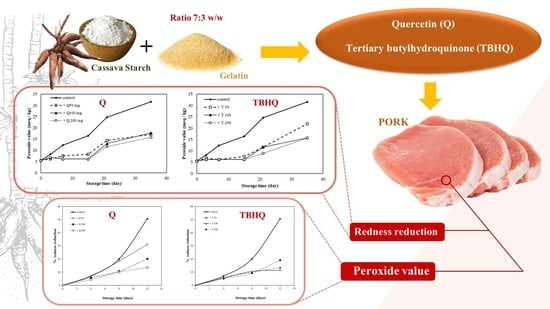Antioxidant Films from Cassava Starch/Gelatin Biocomposite Fortified with Quercetin and TBHQ and Their Applications in Food Models
Abstract
1. Introduction
2. Materials and Methods
2.1. Materials
2.2. Film Preparation
2.3. Film Mechanical Properties
2.4. Fourier Transform Infrared Spectroscopy (FT-IR)
2.5. Differential Scanning Calorimetry (DSC)
2.6. X-ray Diffraction (XRD)
2.7. Film Morphology
2.8. Water Solubility of Cassava Starch/Gelatin Films
2.9. Water Vapor Transmission Rate (WVTR)
2.10. Total Phenolic Content Assay
2.11. Antioxidant Activity Determination in the Composite Films
2.12. Application of Cassava Starch/Gelatin Film Incorporated with Antioxidant
2.12.1. Effect of Antioxidant Addition into Cassava Starch/Gelatin Films on Lard Rancidity during Storage
2.12.2. Estimation of Peroxide Value (PV)
2.13. Antioxidant Films Application on Fresh Pork
2.14. Statistical Analysis
3. Results and Discussion
3.1. Mechanical Properties
3.2. Fourier Transform Infrared Spectroscopy (FT-IR)
3.3. Thermal Properties
3.4. X-ray Diffraction Patterns
3.5. Film Morphology
3.6. Water Solubility
3.7. Water Vapor Transmission Rate (WVTR)
3.8. Total Phenolic Assay
3.9. Antioxidant Activity of the Composite Films
3.10. Application of Antioxidant Films on Lard
3.11. Application of Antioxidant Films on Fresh Pork
4. Conclusions
Author Contributions
Funding
Institutional Review Board Statement
Informed Consent Statement
Data Availability Statement
Acknowledgments
Conflicts of Interest
References
- Debeaufort, F.; Voilley, A.; Meares, P. Water vapor permeability and diffusivity through methylcellulose edible films. J. Membr. Sci. 1994, 91, 125–133. [Google Scholar] [CrossRef]
- Arvanitoyannis, I.; Psomiadou, E.; Nakayama, A.; Aiba, S.; Yamamoto, N. Edible films made from gelatin, soluble starch and polyols, Part 3. Food Chem. 1997, 60, 593–604. [Google Scholar] [CrossRef]
- Arvanitoyannis, I.; Nakayama, A.; Aiba, S. Edible films made from hydroxypropyl starch and gelatin and plasticized by polyols and water. Carbohydr. Polym. 1998, 36, 105–119. [Google Scholar] [CrossRef]
- Arvanitoyannis, I.; Biliaderis, C.G. Physical properties of polyol-plasticized edible films made from sodium caseinate and soluble starch blends. Food Chem. 1998, 62, 333–342. [Google Scholar] [CrossRef]
- Li, B.; Kennedy, J.F.; Jiang, Q.G.; Xie, B.J. Quick dissolvable, edible and heat sealable blend films based on konjac glucomannan-gelatin. Food Res. Int. 2006, 39, 544–549. [Google Scholar] [CrossRef]
- Arvanitoyannis, I.; Biliaderis, C.G. Physical properties of polyol-plasticized edible blends made of methyl cellulose and soluble starch. Carbohydr. Polym. 1999, 38, 47–58. [Google Scholar] [CrossRef]
- Biliaderis, C.G.; Lazaridou, A.; Arvanitoyannis, I. Glass transition and physical properties of polyol-plasticised pullulan-starch blends at low moisture. Carbohydr. Polym. 1999, 40, 29–47. [Google Scholar] [CrossRef]
- Lazaridou, A.; Biliaderis, C.G. Thermophysical properties of chitosan, chitosan-starch and chitosan-pullulan films near the glass transition. Carbohydr. Polym. 2002, 48, 179–190. [Google Scholar] [CrossRef]
- Li, Y.; Shoemaker, C.F.; Ma, J.; Shen, X.; Zhong, F. Paste viscosity of rice starches of different amylose content and carboxymethylcellulose formed by dry heating and the physical properties of their films. Food Chem. 2008, 109, 616–623. [Google Scholar] [CrossRef]
- Tongdeesoontorn, W.; Mauer, L.J.; Wongruong, S.; Sriburi, P.; Rachtanapun, P. Physical and antioxidant properties of cassava starch–carboxymethyl cellulose incorporated with quercetin and TBHQ as active food packaging. Polymers 2020, 12, 366. [Google Scholar] [CrossRef] [PubMed]
- CFR. Code of Federal Regulations: US Government; US Government Printing Office: Washington, DC, USA, 2001.
- Yanishlieva-Maslarova, N.V. Inhibition oxidation. In Antioxidants in Food Practical Applications; Pokorny, J., Yanishlieva, N., Gordon, M., Eds.; Woodhead Publishing Limited: Cambridge, UK, 2001; pp. 22–70. [Google Scholar]
- De Guzman, R.; Tang, H.; Salley, S.; Ng, K.Y.S. Synergistic Effects of Antioxidants on the Oxidative Stability of Soybean Oil- and Poultry Fat-Based Biodiesel. J. Am. Oil Chem. Soc. 2009, 86, 459. [Google Scholar] [CrossRef]
- Phoopuritham, P.; Thongngam, M.; Yoksan, R.; Suppakul, P. Properties of antioxidant cellulose ether films containing selected plant extracts. In Proceedings of the 5th International Packaging Congress & Exhibition, Izmir, Turkey, 22–24 November 2007. [Google Scholar]
- Pascat, B. Study of some factors affecting permeability. In Food Packaging and Preservation: Theory and Practice; Mathlouthi, M., Ed.; Elsevier: London, UK, 1986; pp. 7–24. [Google Scholar]
- Hargens-Madsen, M.; Schnepf, M.; Hamouz, F.; Weller, C.; Roy, S. Use of edible films and tocopherols in the control of warmed over flavor. J. Am. Diet. Assoc. 1995, 95, A41. [Google Scholar] [CrossRef]
- Oussalah, M.; Caillet, S.; Salmieri, S.; Saucer, L.; Lacroix, M. Antimicrobial and antioxidant effects of milk protein-based film containing essential oils for the preservation of whole beef muscle. J. Agric. Food Chem. 2004, 52, 5598–5605. [Google Scholar] [CrossRef]
- Lopez-de-Dicastillo, C.; Hernandez-Munoz, P.; Gavara, R.; Catala, R. Development of packaging films containing natural antioxidants. Characterization of their activity on stimulant and real foods. In Proceedings of the 5th International Packaging Congress & Exhibition, Izmir, Turkey, 20–23 November; pp. 213–222.
- Hanani, Z.A.N.; Yee, F.C.; Nor-Khaizura, M.A.R. Effect of pomegranate (Punica granatum L.) peel powder on the antioxidant and antimicrobial properties of fish gelatin films as active packaging. Food Hydrocoll. 2019, 89, 253–259. [Google Scholar] [CrossRef]
- Shao, X.; Sun, H.; Jiang, R.; Yu, Y. Physical and antibacterial properties of corn distarch phosphate/carboxymethyl cellulose composite films containing tea polyphenol. J. Food Process. Preserv. 2020, 44, e14401. [Google Scholar] [CrossRef]
- Fang, Y.; Fu, J.; Tao, C.; Liu, P.; Cui, B. Mechanical properties and antibacterial activities of novel starch-based composite films incorporated with salicylic acid. Int. J. Biol. Macromol. 2019. [Google Scholar] [CrossRef] [PubMed]
- Nilsuwan, K.; Benjakul, S.; Prodpran, T. Properties and antioxidative activity of fish gelatin-based film incorporated with epigallocatechin gallate. Food Hydrocoll. 2018, 80, 212–221. [Google Scholar] [CrossRef]
- Pellá, M.C.G.; Silva, O.A.; Pellá, M.G.; Beneton, A.G.; Caetano, J.; Simões, M.R.; Dragunski, D.C. Effect of gelatin and casein additions on starch edible biodegradable films for fruit surface coating. Food Chem. 2020, 309, 125764. [Google Scholar] [CrossRef] [PubMed]
- Kowalczyk, D.; Skrzypek, T.; Basiura-Cembala, M.; Łupina, K.; Mężyńska, M. The effect of potassium sorbate on the physicochemical properties of edible films based on pullulan, gelatin and their blends. Food Hydrocoll. 2020, 105, 105837. [Google Scholar] [CrossRef]
- Tongdeesoontorn, W.; Mauer, L.; Wongruong, S.; Rachtanapun, P. Effect of gelatin and carboxymethyl cellulose concentration and relative humidity on cassava starch based film properties. In Proceedings of the 4th China-Europe symposium on processing and properties of reinforced polymers, Guilin, China, 8–12 June 2009; p. 104. [Google Scholar]
- Rachtanapun, P.; Keawsuwan, N.; Kunthaprap, P.; Siriwattanapa, W. Effects of antioxidants in rice and cassava starch film on mechanical properties and study their releasing. In Proceedings of the 8th Annual Meeting of Innovation for Food Industry, Bangkok, Thailand, 15–16 June 2006. [Google Scholar]
- Tongdeesoontorn, W.; Mauer, L.J.; Wongruong, S.; Sriburi, P.; Rachtanapun, P. Mechanical and physical properties of cassava starch-gelatin composite films. Int. J. Polym. Mater. 2012, 61, 778–792. [Google Scholar] [CrossRef]
- Tongdeesoontorn, W.; Mauer, L.J.; Wongruong, S.; Sriburi, P.; Rachtanapun, P. Effect of carboxymethyl cellulose concentration on physical properties of biodegradable cassava starch-based films. Chem. Cent. J. 2011, 5, 6–13. [Google Scholar] [CrossRef]
- ASTM. Standard test methods for tensile properties of thin plastic sheeting D882-91. In Annual Book of ASTM; American Society for Testing and Materials: West Conshohocken, PA, USA, 1991; pp. 1–9. [Google Scholar]
- ASTM. ASTM books of standards. In Standard Test Method for Water Vapor Transmission of Materials E96–80; American Society for Testing and Materials: West Conshohocken, PA, USA, 1980. [Google Scholar]
- Curcio, M.; Puoci, F.; Iemma, F.; Parisi, O.I.; Cirillo, G.; Spizzirri, U.G.; Picci, N. Covalent insertion of antioxidant molecules on chitosan by a free radical grafting procedure. J. Agric. Food Chem. 2009, 57, 5933–5938. [Google Scholar] [CrossRef]
- AOAC International. Total phenolic compound (Quantitative). In Official Methods of Analysis of AOAC International, 16th ed.; Cuniff, P., Ed.; AOAC Int.: Arlington, VA, USA, 1995; pp. 16–17. [Google Scholar]
- Siripatrawan, U.; Harte, B.R. Physical properties and antioxidant activity of an active film from chitosan incorporated with green tea extract. Food Hydrocoll. 2010, 24, 770–775. [Google Scholar] [CrossRef]
- Jongjareonrak, A.; Benjakul, S.; Visessanguan, W.; Tanaka, M. Antioxidative activity and properties of fish skin gelatin films incorporated with BHT and [alpha]-tocopherol. Food Hydrocoll. 2008, 22, 449–458. [Google Scholar] [CrossRef]
- Zhang, C.; Guo, K.; Ma, Y.; Ma, D.; Li, X.; Zhao, X. Incorporations of blueberry extracts into soybean-protein-isolate film preserve qualities of packaged lard. Int. J. Food Sci. Technol. 2010, 45, 1801–1806. [Google Scholar] [CrossRef]
- Jung, D.C.; Lee, S.Y.; Yoon, J.H.; Hong, K.P.; Kang, Y.S.; Park, S.R.; Park, S.K.; Ha, S.D.; Kim, G.H.; Bae, D.H. Inhibition of pork and fish oxidation by a novel plastic film coated with horseradish extract. LWT Food Sci. Technol. 2009, 42, 856–861. [Google Scholar] [CrossRef]
- Najwa, I.S.N.A.; Guerrero, P.; de la Caba, K.; Hanani, Z.A.N. Physical and antioxidant properties of starch/gelatin films incorporated with Garcinia atroviridis leaves. Food Packag. Shelf Life 2020, 26, 100583. [Google Scholar] [CrossRef]
- Martins, J.T.; Cerqueira, M.A.; Vicente, A.A. Influence of α-tocopherol on chitosan-edible film properties. In Proceedings of the International Conference on Food Innovation, Valencia, Spain, 25–29 October 2010; p. 310. [Google Scholar]
- Suppakul, P.; Chalernsook, B.; Ratisuthawat, B.; Prapasitthi, S.; Munchukangwan, K. Plasticizer and relative humidity effects on mechanical properties of cassava flour films. In Proceedings of the 15th IAPRI World Conference on Packaging, Tokyo, Japan, 3–5 October 2006; pp. 433–437. [Google Scholar]
- Mali, S.; Sakanaka, L.S.; Yamashita, F.; Grossmann, M.V.E. Water sorption and mechanical properties of cassava starch films and their relation to plasticizing effect. Carbohydr. Polym. 2005, 60, 283–289. [Google Scholar] [CrossRef]
- Rachtanapun, P.; Wongchaiya, P. Effect of relative humidity on mechanical properties of blended chitosan-methylcellulose film. Chiang Mai J. Sci. 2012, 39, 133–137. [Google Scholar]
- Biswal, D.R.; Singh, R.P. Characterization of carboxymethyl cellulose and polyacrylamide graft copolymer. Carbohydr. Polym. 2004, 57, 379–387. [Google Scholar] [CrossRef]
- Rohn, S.; Rawel, H.M.; Kroll, J. Antioxidant activity of protein-bound quercetin. J. Agric. Food Chem. 2004, 52, 4725–4729. [Google Scholar] [CrossRef] [PubMed]
- Zhang, L.; Kosaraju, S.L. Biopolymeric delivery system for controlled release of polyphenolic antioxidants. Eur. Polym. J. 2007, 43, 2956–2966. [Google Scholar] [CrossRef]
- Aguilar-Méndez, M.; Martin-Martínez, E.; Ortega-Arroyo, L.; Cruz-Orea, A. Application of differential scanning calorimetry to evaluate thermal properties and study of microstructure of biodegradable films. Int. J. Thermophys. 2010, 31, 595–600. [Google Scholar] [CrossRef]
- Almasi, H.; Ghanbarzadeh, B.; Entezami, A.A. Physicochemical properties of starch-CMC-nanoclay biodegradable films. Int. J. Biol. Macromol. 2010, 46, 1–5. [Google Scholar] [CrossRef] [PubMed]
- Rachtanapun, P.; Selke, S.E.M.; Matuana, L.M. Effect of the high-density polyethylene melt index on the microcellular foaming of high-density polyethylene/polypropylene blends. J. Appl. Polym. Sci. 2004, 93, 364–371. [Google Scholar] [CrossRef]
- Bertuzzi, M.A.; Armada, M.; Gottifredi, J.C. Physicochemical characterization of starch-based films. J. Food Eng. 2007, 82, 17–25. [Google Scholar] [CrossRef]
- Domınguez, X.A.; Sanchez, H.; Suarez, M.; Baldas, J.H.; Gonzalez, M.R. Chemical constituents of Lippia graveolens. Planta Med. 1989, 55, 208–209. [Google Scholar] [CrossRef]
- Rachtanapun, P.; Tongdeesoontorn, W. Effect of antioxidants on properties of rice flour/cassava starch film blends plasticized with sorbitol. Kasetsart J. 2010, 43, 252–258. [Google Scholar]
- Bertuzzi, M.A.; Castro Vidaurre, E.F.; Armada, M.; Gottifredi, J.C. Water vapor permeability of edible starch-based films. J. Food Eng. 2007, 80, 972–978. [Google Scholar] [CrossRef]
- Rachtanapun, P.; Tongdeesoontorn, W. Effect of antioxidants on water vapor transmission rate (WVTR) and water sorption isotherm. In Proceedings of the IAPRI World Conference on Packaging, Bangkok, Thailand, 8–12 June 2008. [Google Scholar]
- Pruneda, E.; Peralta-Hernández, J.M.; Esquivel, K.; Lee, S.Y.; Godínez, L.A.; Mendoza, S. Water vapor permeability, mechanical properties and antioxidant effect of Mexican oregano-soy based edible films. J. Food Sci. 2008, 73, 488–493. [Google Scholar] [CrossRef]
- Chung, Y.-L.; Lai, H.-M. Properties of cast films made of HCl-methanol modified corn starch. Starch 2007, 59, 583–592. [Google Scholar] [CrossRef]
- McHugh, T.H.; Krochta, J.M. Milk-protein-based edible films and coatings. Food Technol. Biotechnol. 1994, 48, 97–103. [Google Scholar]
- Nerin, C.; Tovar, L.; Djenane, D.; Camo, J.; Salafranca, J.; Beltren, J.A.; Roncales, P. Stabilization of beef meat by a new active packaging containing natural antioxidants. J. Agric. Food Chem. 2006, 54, 7840–7846. [Google Scholar] [CrossRef] [PubMed]
- Camo, J.; Beltrán, J.A.; Roncalés, P. Extension of the display life of lamb with an antioxidant active packaging. Meat Sci. 2008, 80, 1086–1091. [Google Scholar] [CrossRef] [PubMed]
- Wu, J.-G.; Wang, P.-J.; Chen, S.C. Antioxidant and antimicrobial effectiveness of catechin-impregnated PVA-starch film on red meat. J. Food Qual. 2010, 33, 780–801. [Google Scholar] [CrossRef]
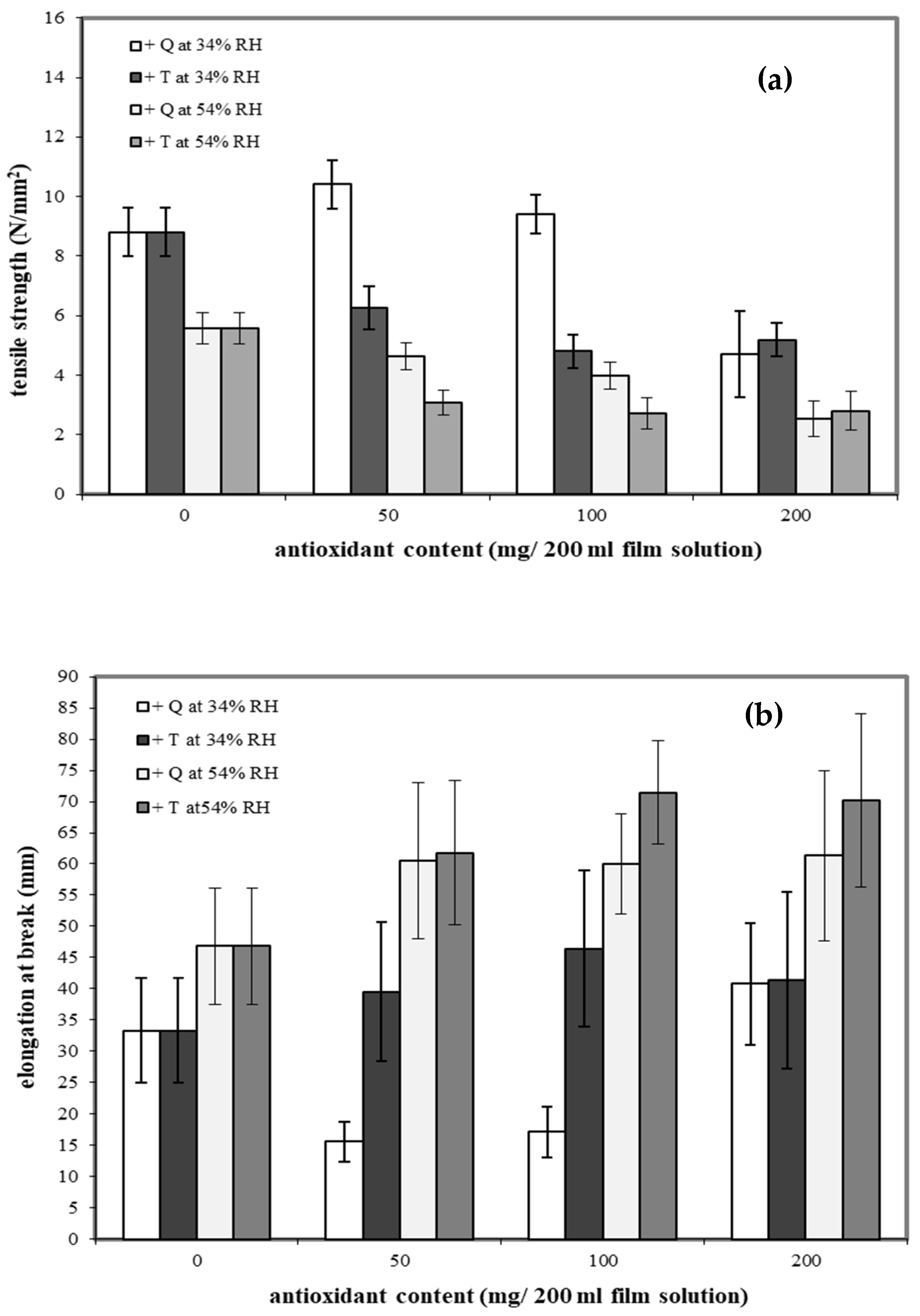
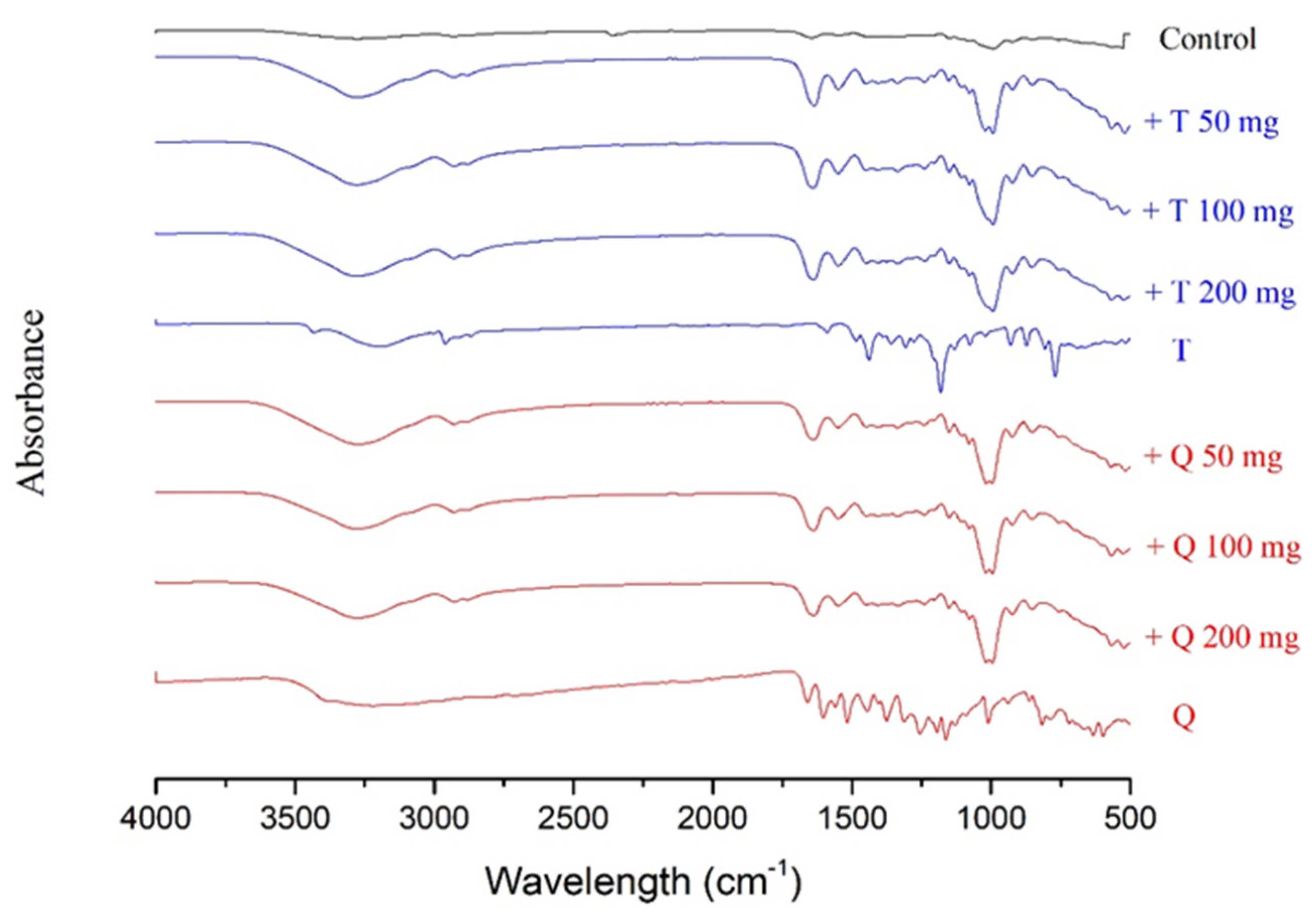

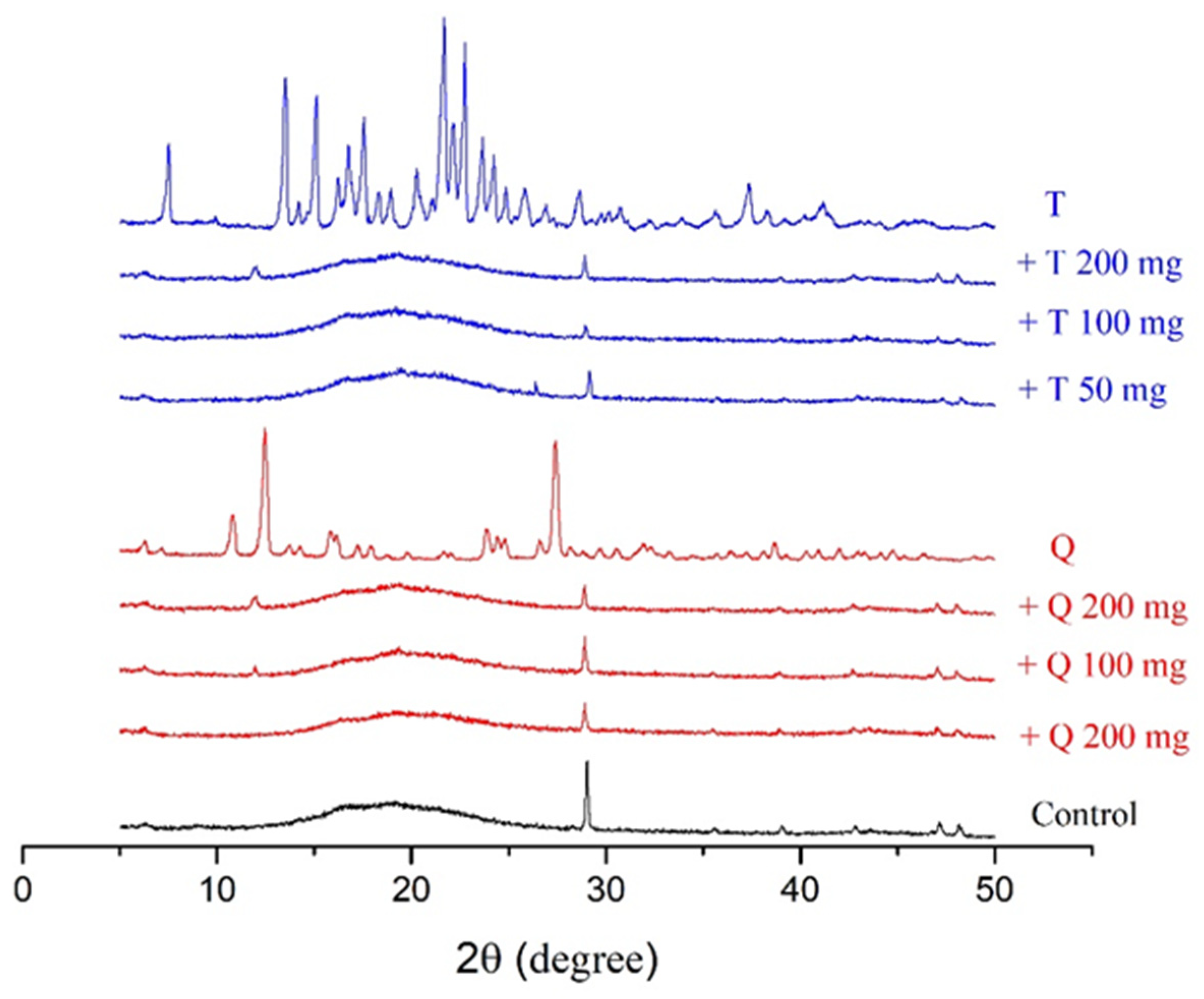




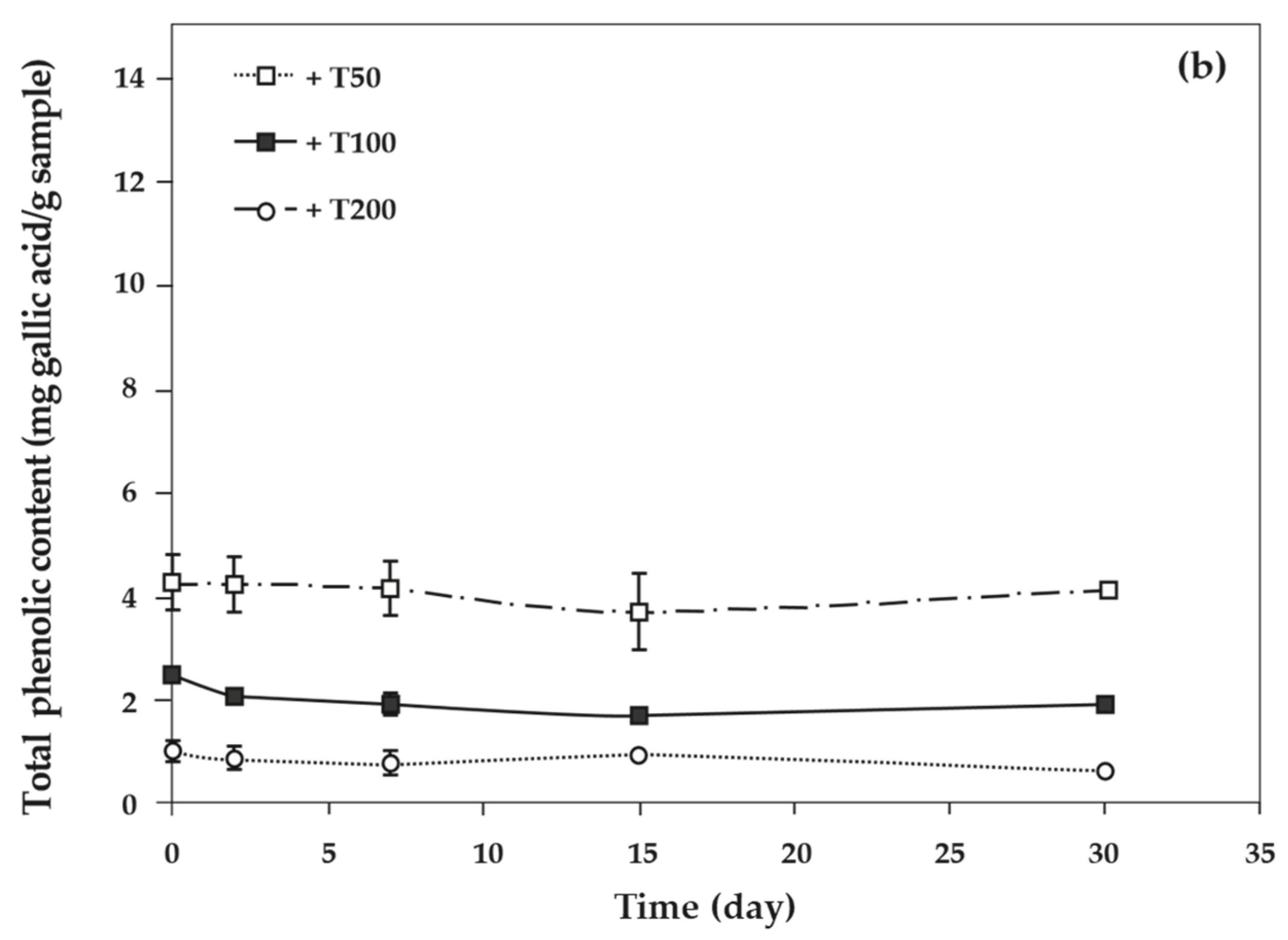


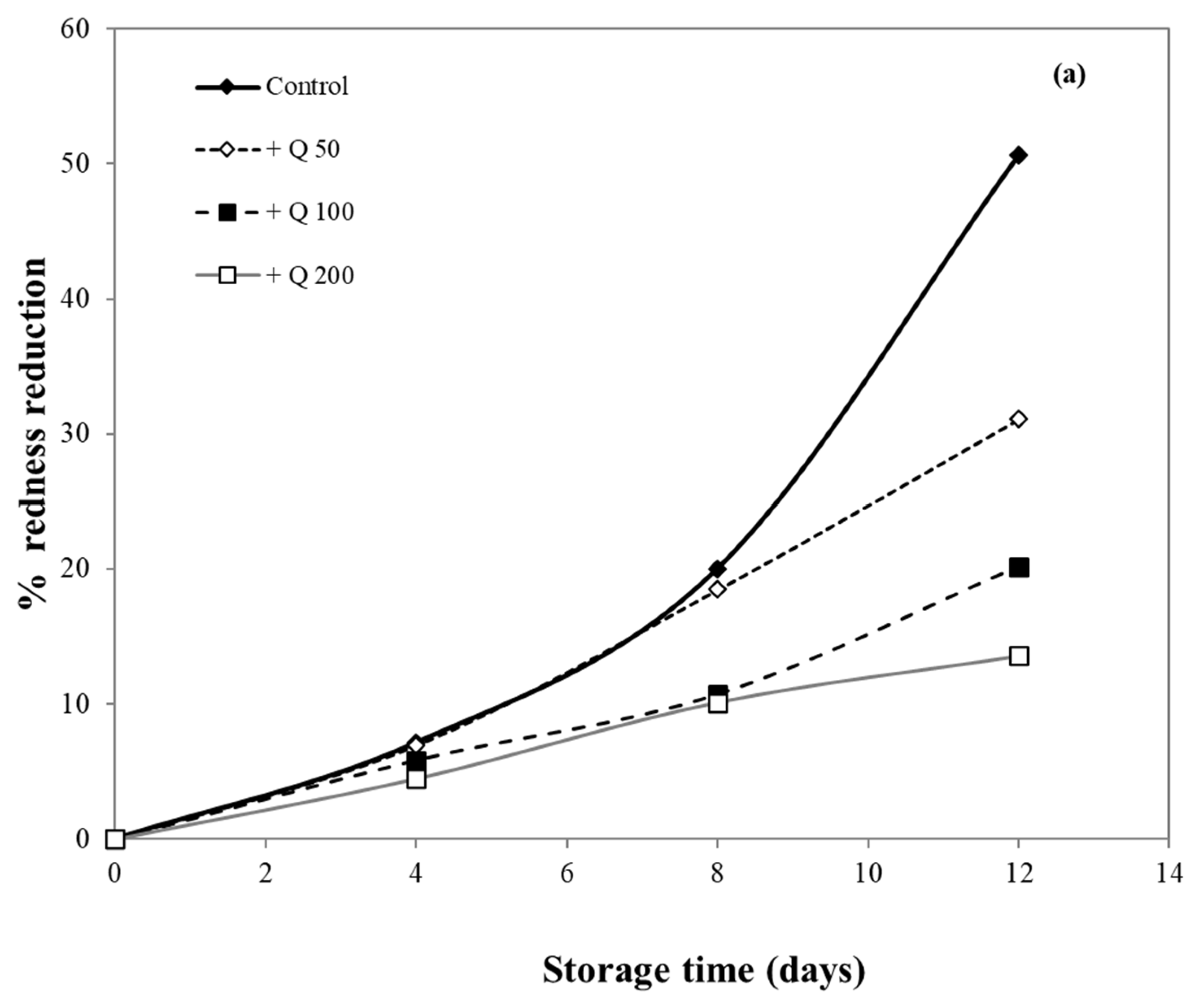
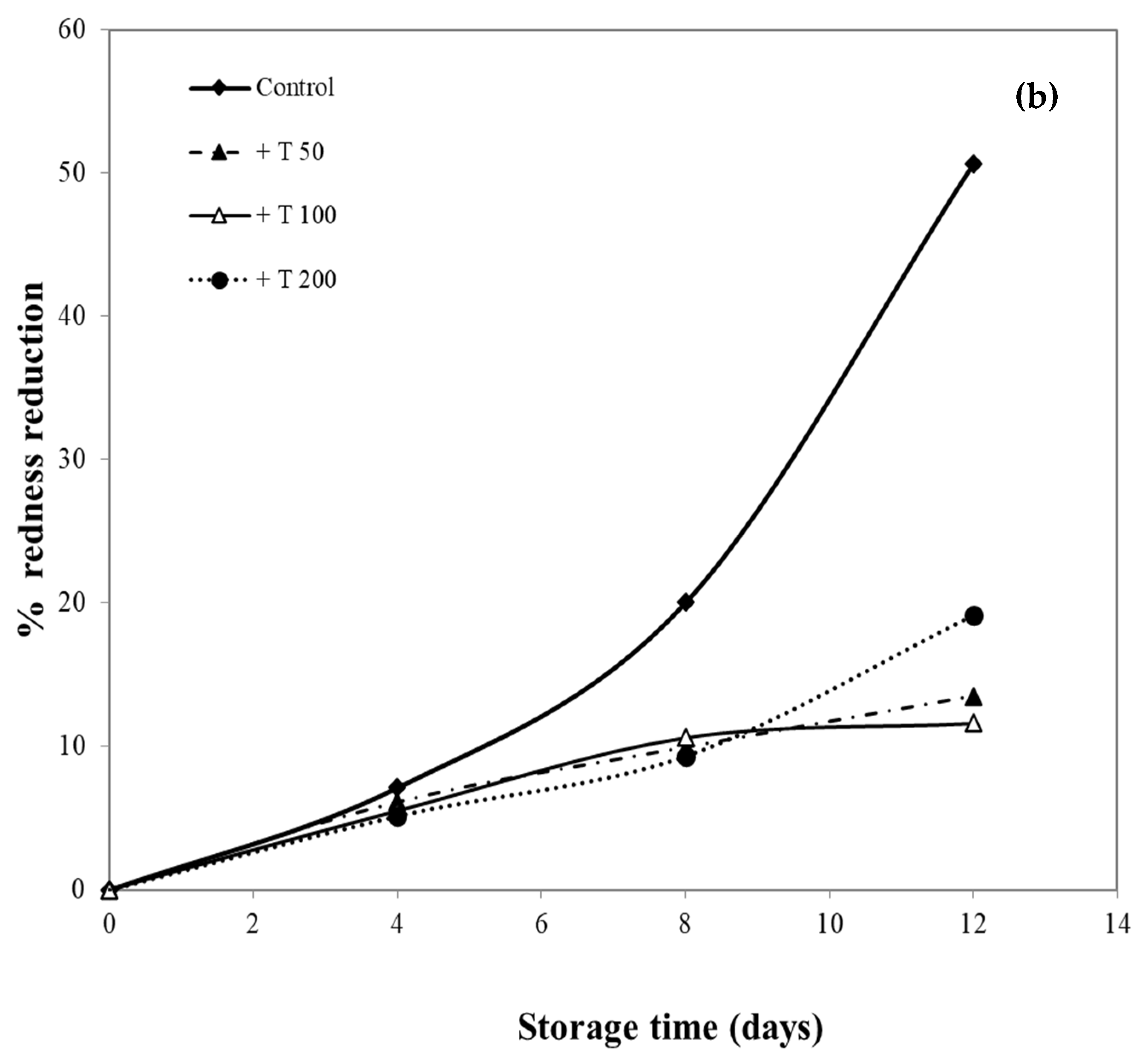
| Film Samples | Composition of Film Solution (g/200 mL Water) | ||||
|---|---|---|---|---|---|
| Starch | Gelatin | Glycerol | Quercetin | TBHQ | |
| Control | 7 | 3 | 3 | - | - |
| Q 50 | 7 | 3 | 3 | 0.05 | - |
| Q 100 | 7 | 3 | 3 | 0.10 | - |
| Q 200 | 7 | 3 | 3 | 0.20 | - |
| T 50 | 7 | 3 | 3 | - | 0.05 |
| T 100 | 7 | 3 | 3 | - | 0.10 |
| T 200 | 7 | 3 | 3 | - | 0.20 |
| Wavenumbers of Peaks (cm−1) | ||||||
|---|---|---|---|---|---|---|
| Control Film | Film + Q50 | Film + Q100 | Film + Q200 | Film + T50 | Film + T100 | Film + T200 |
| 3272.9 | 3272.3 | 3277.1 | 3276.5 | 3274.9 | 3276.5 | 3278.3 |
| 2930.6 | 2928.5 | 2928.3 | 2926.8 | 2930.6 | 2928.8 | 2929.0 |
| 1646.7 | 1637.3 | 1636.4 | 1636.7 | 1634.6 | 1638.2 | 1637.2 |
| 1550.0 | 1550.3 | 1549.2 | 1549.6 | 1550.0 | 1550.6 | 1549.8 |
| 1407.2 | 1405.8 | 1405.1 | 1405.4 | 1405.2 | 1405.6 | 1405.5 |
| 1335.1 | 1335.1 | 1335.1 | 1334.7 | 1335.9 | 1335.7 | 1335.4 |
| 1239.9 | 1239.5 | 1238.3 | 1238.7 | 1238.5 | 1238.8 | 1238.5 |
| 1149.8 | 1150.6 | 1150.6 | 1150.6 | 1151.0 | 1150.5 | 1150.8 |
| 1076.5 | 1078.4 | 1078.0 | 1077.6 | 1077.8 | 1077.5 | 1077.4 |
| - | 1017.3 | 1018.4 | 1017.6 | 1020.2 | - | - |
| 992.3 | 996.0 | 994.4 | 995.5 | 992.9 | 992.6 | 993.4 |
| 923.8 | 924.3 | 924.1 | 924.2 | 923.4 | 923.8 | 923.8 |
| 852.6 | 852.6 | 851.8 | 853.1 | 852.4 | 854.2 | 853.8 |
| Films | Tm (°C) | ΔH (J/g) |
|---|---|---|
| Cassava starch-gelatin | 110.59 ± 2.37 a | 71.21 ± 1.99 a |
| Quercetin | 128.88 ± 3.18 b | 151.00 ± 4.66 b |
| TBHQ | 131.19 ± 5.70 b | 273.56 ± 9.77 e |
| + 50 mg Q | 155.93 ± 3.92 c | 145.09 ± 3.38 bc |
| + 100 mg Q | 177.50 ± 1.87 f | 166.79 ± 1.57 bc |
| + 200 mg Q | 174.41 ± 0.48 | 176.42 ± 2.71 bcd |
| + 50 mg T | 171.34 ± 2.15 | 190.50 ± 13.83 cd |
| + 100 mg T | 166.31 ± 3.73 d | 201.08 ± 6.73 d |
| + 200 mg T | 171.68 ± 0.39 e | 206.29 ± 10.52 d |
Publisher’s Note: MDPI stays neutral with regard to jurisdictional claims in published maps and institutional affiliations. |
© 2021 by the authors. Licensee MDPI, Basel, Switzerland. This article is an open access article distributed under the terms and conditions of the Creative Commons Attribution (CC BY) license (https://creativecommons.org/licenses/by/4.0/).
Share and Cite
Tongdeesoontorn, W.; Mauer, L.J.; Wongruong, S.; Sriburi, P.; Reungsang, A.; Rachtanapun, P. Antioxidant Films from Cassava Starch/Gelatin Biocomposite Fortified with Quercetin and TBHQ and Their Applications in Food Models. Polymers 2021, 13, 1117. https://doi.org/10.3390/polym13071117
Tongdeesoontorn W, Mauer LJ, Wongruong S, Sriburi P, Reungsang A, Rachtanapun P. Antioxidant Films from Cassava Starch/Gelatin Biocomposite Fortified with Quercetin and TBHQ and Their Applications in Food Models. Polymers. 2021; 13(7):1117. https://doi.org/10.3390/polym13071117
Chicago/Turabian StyleTongdeesoontorn, Wirongrong, Lisa J. Mauer, Sasitorn Wongruong, Pensiri Sriburi, Alissara Reungsang, and Pornchai Rachtanapun. 2021. "Antioxidant Films from Cassava Starch/Gelatin Biocomposite Fortified with Quercetin and TBHQ and Their Applications in Food Models" Polymers 13, no. 7: 1117. https://doi.org/10.3390/polym13071117
APA StyleTongdeesoontorn, W., Mauer, L. J., Wongruong, S., Sriburi, P., Reungsang, A., & Rachtanapun, P. (2021). Antioxidant Films from Cassava Starch/Gelatin Biocomposite Fortified with Quercetin and TBHQ and Their Applications in Food Models. Polymers, 13(7), 1117. https://doi.org/10.3390/polym13071117








